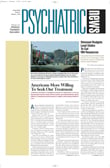Small children who don’t mind their parents, who throw temper tantrums, and who are all charged up physically may be headed down the path to criminal behavior, a British study suggested recently (Psychiatric News, December 7, 2001).
But how about somewhat older youngsters who are simply maddening dervishes of activity? Are they too on track for becoming criminals later in life?
Probably not, unless their behaviors are also accompanied by a conduct disorder, suggests a study reported by German scientists in the October Journal of the American Academy of Child and Adolescent Psychiatry.
Several investigations in the past have implied that having attention-deficit/hyperactivity disorder (ADHD) in childhood increases the risk of engaging in antisocial behaviors in adulthood. But these studies really didn’t look into whether the risk was due to having ADHD alone or to having ADHD combined with conduct disorder. So Sabine Herpertz, M.D., an assistant professor of psychiatry at Aachen University in Germany, and colleagues decided to undertake a study to see whether they could solve this riddle.
They selected for their subjects 21 psychologically healthy boys, 21 boys with ADHD alone, and 26 boys with ADHD combined with conduct disorder. All the boys were between 8 and 13 years of age. All ADHD subjects met DSM-IV criteria for that disorder. All subjects with ADHD and conduct disorder (ADHD-CD) met DSM-IV criteria for both disorders.
Involuntary Responses
They decided to use as their yardsticks of which boys were at risk of becoming future criminals certain involuntary psychophysiological responses that antisocial adults—and particularly adults who show fearlessness, lack of remorse, selfishness, and other enduring personality traits of habitual offenders—are known to display in reaction to acoustical stimuli.
Three of the responses were abnormally low skin-conductance reactions to attention-getting acoustical stimuli; abnormally low skin-conductance reactions to aversive, startling acoustical stimuli; and abnormally quick skin-conductance habituation to aversive, startling acoustical stimuli.
To assess subjects’ reactions, the investigators seated all three groups of their subjects comfortably in a lab. First they measured the amplitude—that is, extent—of subjects’ skin-conductance reactions to attention-getting acoustical stimuli. They then compared the results from all three subject groups.
The ADHD-CD subjects, they found, showed significantly less extensive skin-conductance reactions to the stimuli than did the ADHD subjects and the controls.
Next, the researchers measured the amplitude of the subjects’ skin-conductance reactions to aversive, startling acoustical stimuli and compared the results from the three study groups. The extent of the responses by ADHD-CD subjects, they found, was significantly lower than that of ADHD subjects and also lower, although not significantly so, than that of controls.
Finally, the scientists measured, via skin-conductance reactions, how quickly subjects got used to aversive, startling acoustical stimuli and again compared results from the three groups. The ADHD-CD subjects got used to the stimuli significantly earlier than the ADHD subjects and controls did, the investigators found.
Taking these results together, Herpertz and her team concluded in their study report, “Boys with ADHD plus CD showed a psychophysiological-response pattern that is very similar to that reported from studies with psychopathic antisocial personalities.”
Timothy Brewerton, M.D., a professor of psychiatry and behavioral sciences at the Medical University of South Carolina and a member of the APA Council on Children, Adolescents, and Their Families, told Psychiatric News that he thought the study is an important one “because it helps to dispel the commonly held belief that attention-deficit/hyperactivity disorder itself leads to delinquency.”
Psychophysiological Predictors?
Psychiatric News also asked Adrian Raine, Ph.D., a professor of psychology at the University of Southern California and an internationally recognized authority on the psychophysiology of criminals, to assess the study results. “The findings make good sense within the wider context of what is known about the psychophysiological activity in antisocial groups,” he said. “The fact that the hyperactive-only group does not show psychophysiological markers for antisocial behavior supports the importance of distinguishing between hyperactive children with and without comorbid antisocial behavior.
“The fact that hyperactive children with conduct disorder show psychophysiological characteristics of antisocial and psychopathic adult individuals,” he continued, “is also supportive of [the] position that hyperactive children comorbid for conduct disorder may be ‘fledgling psychopaths.’ Nevertheless, due care must clearly be taken in extrapolating from these psychophysiological findings to the clinical practice of predicting who will and will not develop problem behavior. An important future question,” he added, is “whether psychophysiological measures will be capable of predicting problem behavior in later adolescence and early adulthood.”
Indeed, Herpertz and her colleagues agreed with Raine on this last point. “Further research should include longitudinal studies testing whether psychophysiological responses increase our ability to predict outcome of boys with extroversive disorders,” they wrote in their study report. Herpetz told Psychiatric News that she and her colleagues will now be undertaking such a study.
The study by Herpertz and her team was funded by the Interdisciplinary Center for Clinical Research of the Medical Faculty, RWTH Aachen, Germany, and the German Society for the Advancement of Scientific Research.
An abstract of the study report, “Psychophysiological Responses in ADHD Boys With and Without Conduct Disorder: Implications for Adult Antisocial Behavior,”can be accessed on the Web at www.jaacap.com by typing the article title in the “Quick Search” box. ▪
